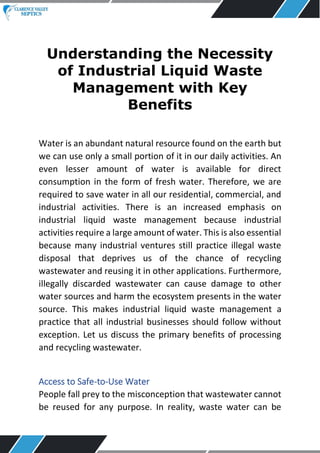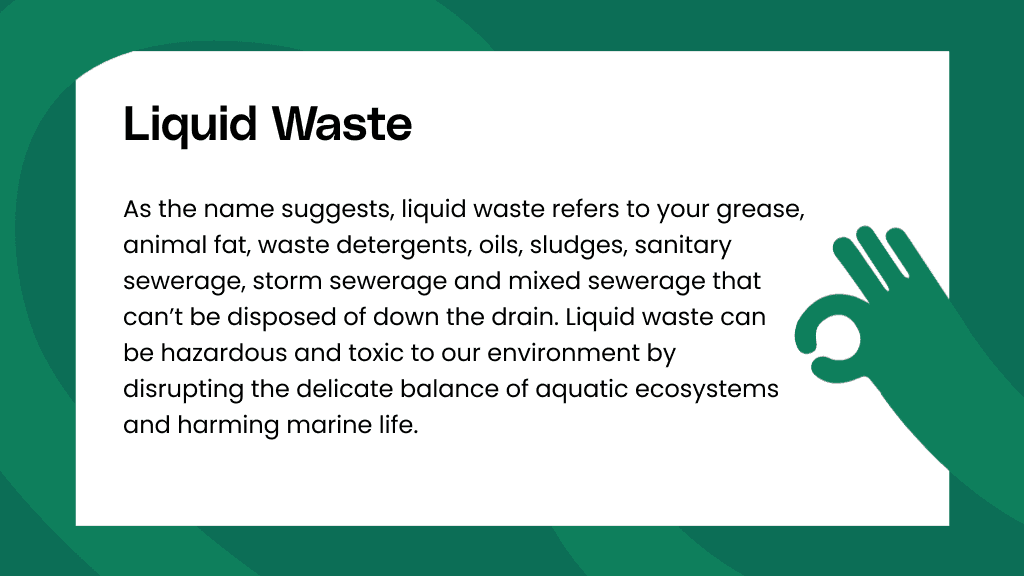8 Simple Techniques For Reclaim Waste
8 Simple Techniques For Reclaim Waste
Blog Article
Examine This Report on Reclaim Waste
Table of ContentsReclaim Waste Can Be Fun For AnyoneSome Known Details About Reclaim Waste The 45-Second Trick For Reclaim Waste6 Easy Facts About Reclaim Waste ExplainedA Biased View of Reclaim WasteThe Definitive Guide for Reclaim Waste
Via correct fluid waste management, firms can lower energy-intensive treatment procedures and disposal prices. They additionally reach save resources and assign them in various other appropriate processes. There are many policies that safeguard public health and wellness and the atmosphere. By complying with a system for handling liquid waste, companies can prevent expensive penalties and fines and prevent adverse attention.Stay ahead of guidelines and keep a safe work environment with a digitized conformity device. Identifying liquid waste is critical for effective storage, therapy, and disposal. Environmental, Health, and Safety And Security (EHS) teams, waste management policemans, and conformity managers can take care of these wastes securely and effectively when they recognize the essentials: Created from families, this kind of liquid waste comes from toilets, sinks, showers, and cleaning equipments.
(https://sketchfab.com/reclaimwaste1)Accumulate representative samples from different factors within the waste stream to make sure precision. Conduct periodic testing to track any type of changes in the composition. Maintain comprehensive documents of characterization for future referral and compliance purposes. Liquid waste, especially unsafe ones, positions considerable threats during this step. Correct treatments minimize spills, leakages, and various other accidents that might hurt the workers and the general public.
The Of Reclaim Waste
Set apart the waste based upon its kind (e.g., harmful or non-hazardous) to make certain appropriate handling. Store waste in secure and leak-proof containers to prevent spills during collection. Label the containers appropriately, including the type of waste, possible dangers, and dealing with instructions. Lots the protected bins into transportation cars with vacuum trucks or portable tanks.
Sanitation (e.g., chlorination, ultraviolet light, ozonation) and nutrient elimination (e.g., denitrification and phosphorus elimination) are advised under rigorous guidelines. Numerous business went against several liquid waste disposal laws in recent years.
After selecting the ideal kind of therapy method for liquid waste, firms must find means to get rid of this effectively. Below are some reliable techniques of liquid waste monitoring: obtain most treated fluid waste that fulfills discharge standards. describes making use of treated wastewater in agricultural lands for watering as long as the effluent satisfies sanitary levels per guidelines.
Reclaim Waste Can Be Fun For Everyone
Shallow basins include liquid waste that is allowed to vaporize with natural procedures. This kind of disposal is subject to strict ecological guidelines due to potentially dangerous emissions.
The searchings for ought to be recorded, assessed, and saved not just for entry to regulatory authorities but also for making enhancements in the future. Share info with relevant stakeholders (e.g., workers, regulatory federal government agencies, and nearby communities) to maintain transparency and responsibility.
Reclaim Waste Fundamentals Explained
Regardless of the firm dimension or industry, there are numerous difficulties linked with this job. Companies that can't spend in facilities ought to consider working together with the public field for much better remedies (industrial wastewater treatment).
Fluid waste describes any type of material in a fluid state that is excess, undesirable, or disposed of. One considerable challenge for business is the lack of proper storage centers for liquid waste. Partnering with fluid waste services will significantly lessen this obstacle Requirement skip containers and various other containers that are generally used for solid waste are usually inadequate for the one-of-a-kind demands of taking care of liquid products.
An Unbiased View of Reclaim Waste
This blog explores the attributes of liquid waste, going over how spills and contamination events can be handled properly. It also checks out the measures companies can take to avoid future leaks and what to do when spills unavoidably happen. Fluid waste contains any kind of undesirable or surplus product that exists in a fluid form and is set for disposal.
This kind of waste arises when a product is no longer needed, a lot like any type of other form of trash. It is crucial to involve experienced fluid waste administration professionals when transferring or disposing of fluid waste.

The 30-Second Trick For Reclaim Waste
The Environmental Defense Agency mentions the "material has to pass with a 0.45-micron filter at a stress differential of 75 psi" in order to be defined as a fluid. What is necessary to keep in mind right here is that the extra solid a product is, the less likely it is to be fluid. It's possible to separate in between two kinds of fluid waste: organic and not natural. Both have their differences.
Both services and people can significantly benefit from recognizing correct trash disposal processes with 9 finest methods in waste monitoring. These approaches are aligned with why not find out more the established waste hierarchy.

Report this page